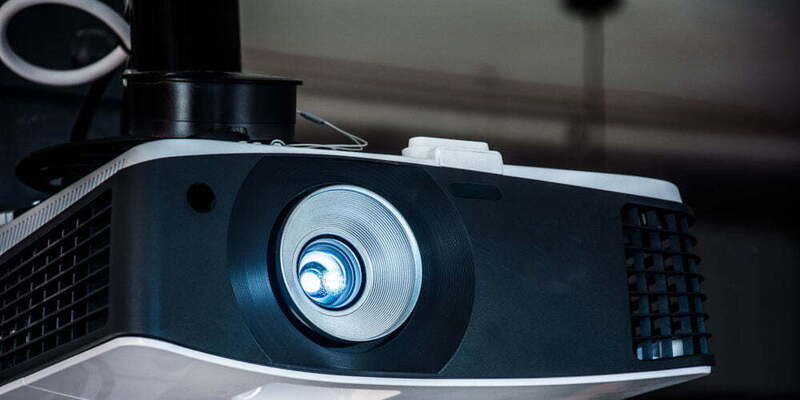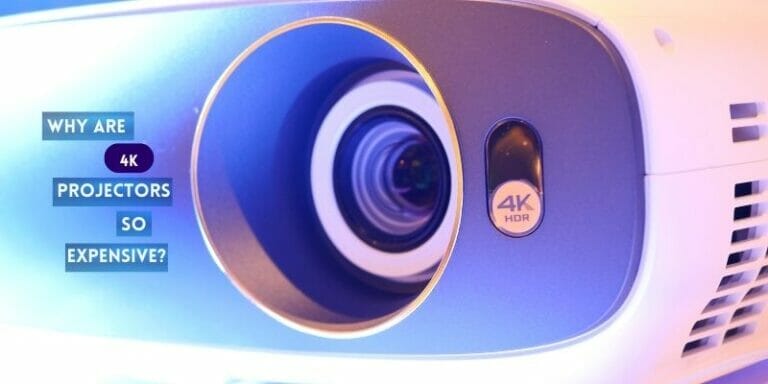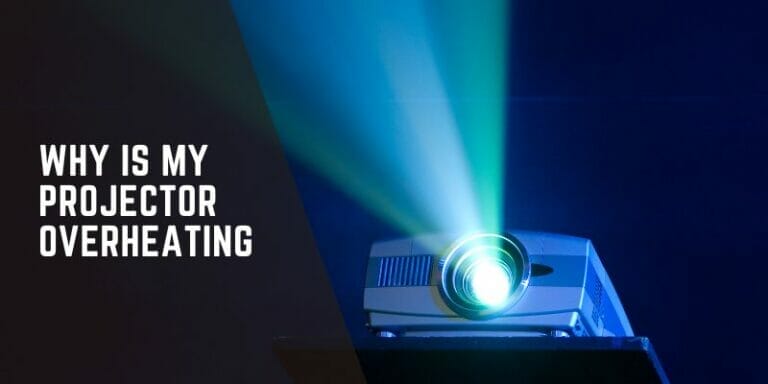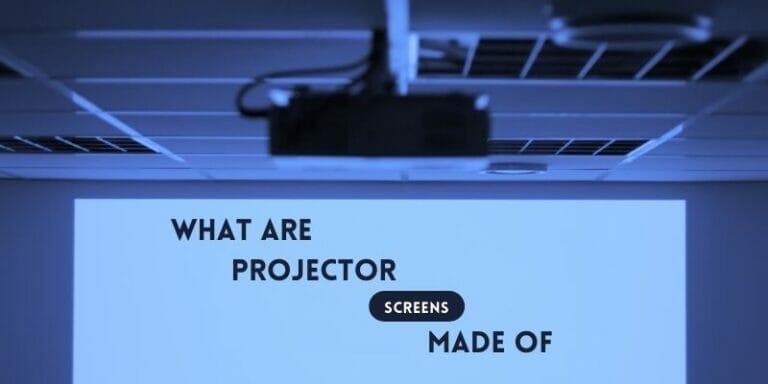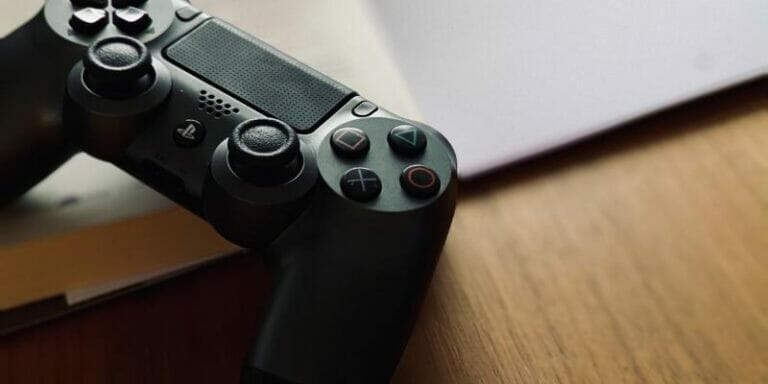How to Run Power to Ceiling Mounted Projector – Easy Method
Running a projector is an easy task if you have the right tools and knowledge. The best way to run a projector is by using a power to ceiling mount projector. This can be the best way to run a projector because of its ease of use and convenience.
There are many advantages of using a power to ceiling mount projector over other types of projectors.
How to Run Power to Ceiling Mounted Projector
Running a projector is simple if you have the right equipment and know how to use it. You don’t need any special skills to run a projector. You just need to know how to operate it and know where to install it.
Most projectors are too big to fit under a flat screen. This means that you cannot simply place it under a flat screen and use it.
Some people have reported that they have a very good experience with ceiling mounted projectors.
One advantage of having a ceiling mount projector is that you don’t have to worry about anything else except installing and operating the projector. You just have to focus on how to operate the projector.
Design a power outlet for projector
To make installation easier. A power socket should be used to connect your power source to the projector.
There are three different types of power sockets: the four-pronged plug, the eight-pronged plug, and the 12-pronged plug. All three plugs are made to support devices that have been designed to plug into the wall.
If you want to design a projector power outlet, you can either buy a pre-made power socket or you can buy a custom made power socket.
If you want to purchase a power socket, you can buy the one that has the right number of outlets and prongs to match the projector that you intend to use.
To install the projector in your room, you will need to find an outlet that has enough power to support the projector. The projector should be connected to a power socket that has the same number of outlets as the projector.
Methods To Install Ceiling Mounted Projector:
1: Screw it into the ceiling
One method of installing a ceiling mounted projector is to screw it into the ceiling. It is a fast and easy method of installation. It is not necessary to cut holes in the ceiling to install a ceiling mount projector.
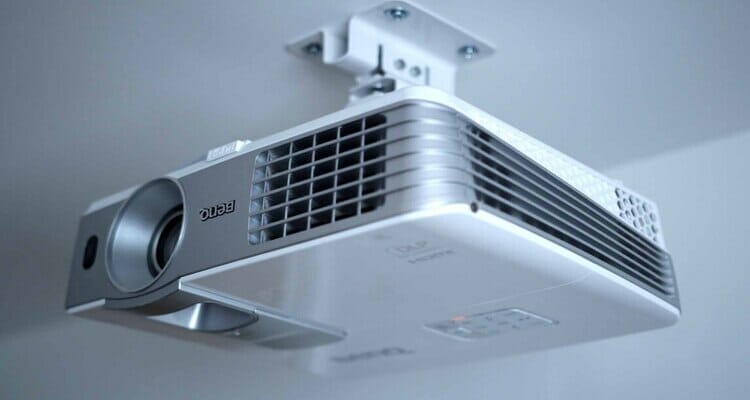
- The first step is to measure the distance between the ceiling and the projector. You can do this by using a ruler.
- After that, you should hang the projector using a fixture that is compatible with the projector.
- If you are looking for a simple and quick way to install a ceiling mounted projector, this option is definitely for you. You will need to screw the projector into the ceiling. You will only need a small tool to do this.
- Once it’s screwed into place, you will need to use a fixture that is compatible with the projector.
- Ceiling mounted projectors are useful. They allow you to enjoy high definition videos and pictures. You can also project videos or images onto large screens.
- A ceiling mounted projector can be used in various ways. You can use it as a mirror if you are going to work out. You can also use it to project the news or a video while you are watching a movie.
2: Connection
The most common methods to install a ceiling mount projector are screw and clamp. Both methods are pretty easy to do.
However, there are advantages and disadvantages with both methods. Screws are very easy to use but may be time consuming depending on the size of your projector.
3: Clamps
Clamps are much quicker than screws and easier to use. However, clamps may not give you the same level of stability as screws.
Screws can be used for any type of projector while clamps can only be used for certain types of projectors.
Most projectors can be mounted with a single screw or clamp. The screws and clamps can hold the projector firmly enough. The only disadvantage of using screws or clamps is that they are time consuming to install.
They are also harder to remove if you want to change out the projector. If you want to use clamps for your projector, you will need to consider the type of projector that you are using.
You may need to use different sized clamps depending on the size of your projector. Some projectors cannot be mounted securely with clamps because they may not be strong enough.
If you choose to use a screw, you will need to measure the distance between the ceiling and the projection screen.
4: Power Outlet for Projector
Before you do this, make sure that there is no power outlet next to the projector. If there is a power outlet next to the projector, make sure to keep it away from the projector.
Use the screws provided in the projector to mount the projector onto the wall. For most projectors, the screws will be located inside the frame.
If there is no screw inside the frame, you will need to drill a hole for the screws to be placed. Once the screws are installed, you will want to put a clamp around the screws so that the projector is held in place. You will need to measure the distance from the projector to the ceiling to determine how big the clamp needs to be.
Advantages of Using a Power to Ceiling Mount Projector:
There are many advantages of using a power-to-ceiling mount projector over other types of projectors.
One advantage of having a ceiling mount projector is that you don’t have to worry about anything else except installing and operating the projector. You just have to focus on how to operate the projector.
Another advantage of using a ceiling mount projector is that it can be used as a standalone projector or a home theater system. You can connect your home theater equipment to the projector such as a TV, Blu-ray player, DVD player, etc.
Disadvantages of Using a Power to Ceiling Mount Projector:
There are some disadvantages of using a ceiling mount projector. For example, if you use a power-to-ceiling mount projector, then you need to have the appropriate mounting hardware for the ceiling mounted projector.
The mounting hardware can be used to fasten the ceiling mount projector to the ceiling. This will allow you to mount the projector in any place on the ceiling.
You can choose any part of the ceiling for this purpose. You can also use the mounting hardware to fasten the ceiling mount projector to the wall.
You can even use the ceiling or the walls. The mounting hardware is designed for all sorts of ceiling mount projectors. There are many ceiling mount projector manufacturers.
FAQs
How Do You Hide the Wires from a Ceiling Mounted Projector?
There are a few ways to hide the wires from a ceiling-mounted projector:
Cover the wires with a cable cover
Run the wires behind the wall or ceiling
Install a ceiling mount concealer
How Do You Power a Projector?
There are a few ways to power a projector. The most common way is to use a power cord connected to the projector’s power outlet. Other ways to power a projector include using batteries or using an AC adapter.
What Wires to run to ceiling mount Projector?
There are a few different types of wires you will need for a projector. The most common are power and signal wires. Power wires run from the projector to a power outlet, and signal wires run from the projector to the screen.
Should I Ceiling Mount My Projector?
It depends on what you are planning to do with the projector. If you are going to be viewing it in a darkened room, then you may want to consider mounting it. If you are planning to use it for home videos, then you probably don’t need to mount it.
The reason for this is that you will have to get the projector close enough to the screen so that it can project images onto the screen. This can be difficult if you are mounting the projector near a wall or ceiling.
In Last:
You will need to take the time to get the projector installed properly if you plan to enjoy it for years to come.
The first step is to ensure that the projector is securely mounted on the wall. You will need to use the screws provided in the projector to mount it on the wall.
Once the screws are installed, you will need to make sure that they are firmly in place. If they are not firmly in place, the projector may shake when it is in motion or hit something while it is being moved.

